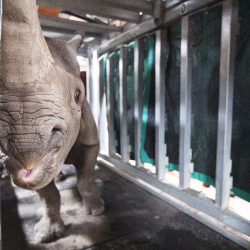Day 9
By Dr. Hal Schott
Today, we left the comfort of our Veracruz city hotel and drove the vans several hours to a very remote community called Santa María Tetetla. We pulled into a rough parking area adjacent to a bridge crossing a small river and were greeted by groups of braying burros—the day could be nicknamed “utter chaos.” Fortunately, as we were unloading our vans and drawing up vaccines, José and Humberto started talking with all of the equid owners and developed lists and number of animals to create some semblance of order for the day. The burros in this community were largely used for hauling various types of produce to markets several hours away. Thinking about the very bumpy and slow progress we made over the last hour of the drive, it was obvious why burros were ideally suited for this community.
We broke up into our teams and got to work. By the end of the day, we had examined 208 burros, 44 horses, and 33 mules. Although most of the male burros were not castrated, there was neither time nor a good location for castrations at this work site. In addition to vaccinating and deworming most of the equids, we also performed four dentals, palpated four mares for pregnancy, and trimmed the feet of 25 animals. We again saw a number of ticks on the ears and around the anus of several animals and a new finding—vampire bat bites on the upper leg and lower neck of several animals.
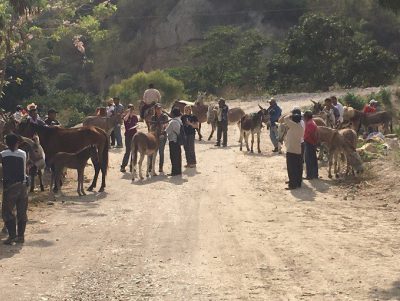
Overall, the equids in this community were not as well behaved as in the other communities where we had worked. It had been about five years since the Donkey Sanctuary staff had last visited this community, and we were warned that the owners did not have the knowledge about how to more effectively work with their animals. Thus, we saw more ear twisting and sticks being used to discipline the animals, rather than the better interactions we had seen in other communities. This difference made it clear to us that education and repeat visits by the Donkey Sanctuary truly improve equid welfare in more ways than simple veterinary care.
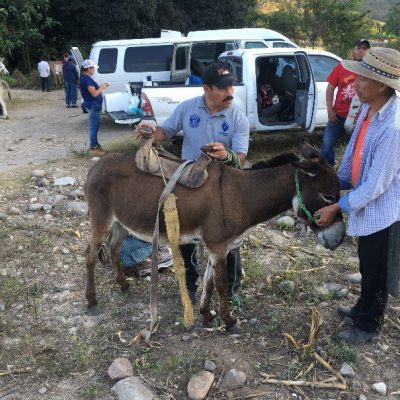
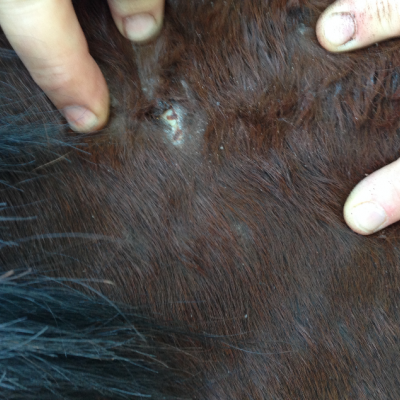
Alex also examined a mare that was laying down and acting colicky—it was reported to have aborted a fetus the day before. The mare was dehydrated. Alex passed a stomach tube and we gave it a dose of Banamine and about a gallon of water from the local river, using a large pop bottle as a funnel. Rectal palpation revealed a lot of dry manure in the rectum, but a vaginal exam was normal, and within a few minutes, the mare passed more manure and appeared to be on the road to recovery. We also saw a horse that was quite lethargic and in poor body condition. The oral membranes were quite pale and the mare had a systolic heart murmur, likely from anemia. Piroplasmosis was the likely diagnosis but we did not have any medications for treatment of this problem.
Fortunately, we all survived the day and both the MSU and UNAM students gained a lot of experience working with more difficult equids. The faculty and Donkey Sanctuary staff could see the students’ confidence blossom as the day progressed, and all were exhausted as a beautiful half-moon started to rise in the sky. At the end of the day, we were invited to a community dinner where they shuffled together a number of tables in the street outside one of the community member’s houses. For desert, we enjoyed bags of dry roasted peanuts, one of the products of the community. As we loaded up in the vans after dinner, it also was time to say goodbye to Dr. Bunn. He was driven back to Veracruz to catch a flight home early the next morning while we headed to our new hotel in the city of Xalapa.
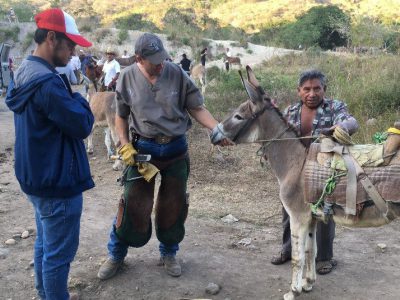
Day 10
by Mackenzie Gallegos and Olivia Hornace
We started the morning by walking through beautiful downtown Xalapa to get breakfast. There were many amazing buildings, including a cathedral, to look at along the way. The architecture and colors were gorgeous. At the restaurant, we watched a woman hand make tortillas and sopes. They were delicious, just like the rest of the food. On the way back to the vans, we could see the highest mountain peak in Mexico, the snow-capped volcano Pico de Orizaba (5,636 m or 18,491 feet high), in the distance.
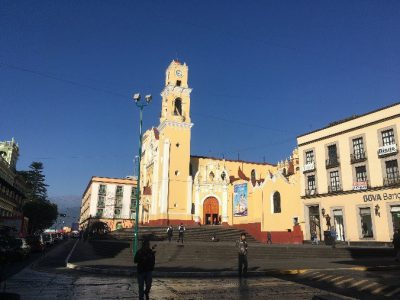
We then crammed back into the vans for the hour-and-a-half drive to the community of Miahuatlán. Members of this community primarily work in nearby cheese factories, and many own small herds of cows that they milk by hand each day. The milk is then transported by horse or donkey to the cheese factories, where it is sold for 5.40 pesos/L (27 cents/L). On our drive in, we also saw many people loading their donkeys with large jugs filled with water from the community well. This water is collected daily and used in the household for drinking, cooking, and other purposes. Needless to say, the animals of this community are essential for both economic and livelihood purposes.
When we arrived at the work site, we were greeted by a small crowd of donkeys, horses, mules, and their owners. We split up into four teams to start our exams. José again made a “client list” and divided the names among the teams to make getting to everyone easier. Our teams were becoming well-organized and more efficient!
Today’s clinic was located in a small field next to the local Agriculture Association building. During this clinic, I (Mackenzie) worked at a physical exam station with MSU classmate Emily and UNAM students Flora and Carlos. We assessed the equids’ overall health, behavior, body condition, skin, and feet, and then we vaccinated and dewormed the animals as primary preventative therapies. My UNAM colleagues Flora and Carlos were really impressive when dealing with more difficult equids. I learned a lot from just observing their methods of slowly approaching and quickly vaccinating those animals. My goal for the day was to become more comfortable aging horses by their teeth. I believe I accomplished this goal when I aged a horse and two of my classmates aged her the same!
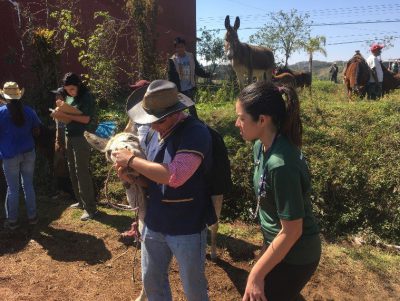
The primary problems seen in this community were harness wounds from poorly fitted saddles and overloaded cargo. This makes sense because of the importance of the animals for economic purposes and the cargo being milk. We sent many horses to see Luis Aguilar, who specializes in fitting saddles and harnesses.
Midway through the day, a group of men wearing cowboy hats rode up on beautiful horses. It was a quite surreal experience watching these skilled riders navigate through the field of waiting donkeys and horses. It reminded me of Rio Bravo or another old western movie with the sheriff riding into town. These cowboys were part of the livestock and agriculture association and important people within the community. At the end of the day, I watched UNAM intern, Bernie, remove wolf teeth from a stallion. I also assisted “the General” in a field castration. It was the first time I had seen both procedures done. Some of the community men watched the castration and I joked with them “Quien es próximo?” Most of the stallions in this community were left intact unless they had specific behavior issues like jumping fences to get to mares. That’s just a fun fact because I don’t think I asked why this particular stallion was being castrated.
I (Olivia) participated in about five of the dentals today. I am really starting to enjoy them. Before this trip, I had only held for the doctors, which wasn’t always the most fun, especially when we did 15 Percheron dentals in a day. But being able to perform them on my own was very rewarding because I was making a difference in these working equids' lives.
In total, we examined 85 equids, mostly horses with a few donkeys and mules. We performed 12 dentals and 3 castrations. Unfortunately, part way through the day, we ran out of our tetanus combo vaccine (500 doses had been donated to our project), so, we could only deworm the remaining animals.
After our work day, we walked down the street to a home/store where a family had prepared us dinner. We ate Bistek a la Mexicana, and it was the most delicious food I’ve ever eaten. I’m quite sure I (Mackenzie) could eat it every day of my life. We thanked the family and the cooks, two women smaller than me (I am 5 feet tall) for their hospitality and amazing food. We walked away as the sun was setting, and I really felt humbled by the day. There are so many other places I could be, but today, I spent the day in Miahuatlán, outside in the sun vaccinating stallions and burros while speaking (poor, but passable) Spanish. We left shortly after dusk and headed back down the windy, bumpy road back to Xalapa. However, since the drive was comparably short and we were done a little earlier today than on previous days, we stopped for some shopping in Naolinco. This town is well known for leather goods, and there were many shops with boots, shoes, sandals, belts, and bags. A couple of the girls went shoe crazy because the deals were too good to pass up. I really wanted a pair of the brightly colored sandals, but unfortunately, I could not find a pair in my size that I really liked. We then returned to our hotel for the night.
Day 11
by Sam Gamble
Today, we woke up after our last night in Xalapa and ate breakfast at the local restaurant. Afterward, many of the team stopped to buy Veracruz coffee (to take back to the States) on the way to the vans. After about an hour, we reached the city of Mazatepez and decided to have one of our final lectures about the importance of assessing the community. José, a sociologist with the Donkey Sanctuary, and Humberto, an anthropologist with the Donkey Sanctuary, talked about the importance of the community and the equid-human relationship in the work of the Donkey Sanctuary. They emphasized the importance of their work as sociologists and anthropologists in reaching many goals of the Donkey Sanctuary, which not only involve veterinary work, but also work that involves the community that can allow for a sustainable solution for the communities and the welfare of their equids. As we were sitting and listening to lectures, we watched as a boy walked his horse down the rocky terrain carrying a load of firewood. Mariano also showed us some examples of the importance of not jumping to conclusions about cases when wounds are present. He introduced us to a man who had his son handling their horse.
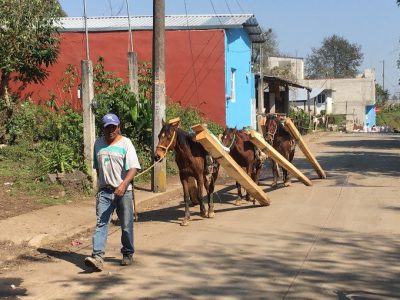
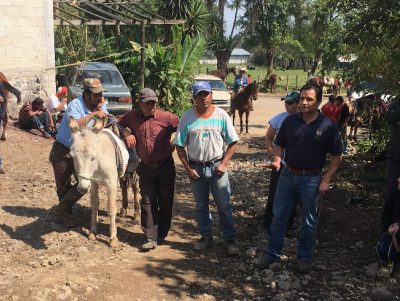
The horse had evidence of previous saddle wounds across his back that had healed. Mariano mentioned that many people may think that this man did not take good care of his horse, but in reality, he had owned the horse for 10 years from the time he was a colt, and that the animal developed bursitis once from the hard labor and the General had come out to treat it. Also, the man trusted his young son to handle the horse that was very well behaved, indicating the close bond between the horse and the family. Humberto also emphasized the importance of listening and learning about a community and its reliance on working equids. Although some traditional practices or treatments, such as placing a copper wire in the ear as a treatment for sarcoids, may not seem correct to us as veterinarians and students, it is important to understand how and why the treatment may have been pursued before passing judgement. Only once we understand a community can we effectively engage and offer further education to improve welfare of both working equids and the owners they serve. As part of their jobs with the Donkey Sanctuary, both José and Humberto may live in communities for periods of time to get to know the residents and observe their daily lives. This may include going to work with them, following them for some time to learn daily habits and traditions, learning how and why the different type of equids are being used, and getting to know important community leaders.
Following the discussion, we began working. We saw many horses walking by that were carrying wood and corn stalks, but there was only one donkey present. Earlier in our talk, it was explained that a few years ago, a man had come to the community and offered 1,200 pesos (which is roughly $60) to buy donkeys. Many people sold their donkeys, not realizing that they were going to be sacrificed to harvest their skins for the extraction of skin oils to make “anti-aging” creams for the market in China. The only donkey present today was owned by a man who said he did not sell his burro because it was too important for his family. Because of this massive selling off of donkeys, horses are the only working equids in the community, but they require two to three times the amount of food each week than a donkey consumes. Today, donkeys cost 2,000–3,000 pesos ($100–150), and many people who sold their donkeys wish they still had them because they considered them better for carrying certain loads in the mountainous terrain surrounding this community.
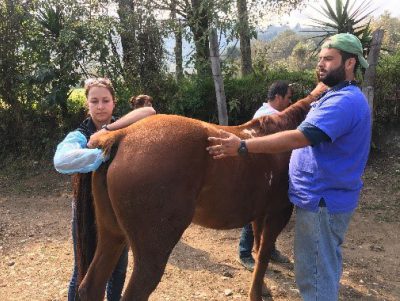
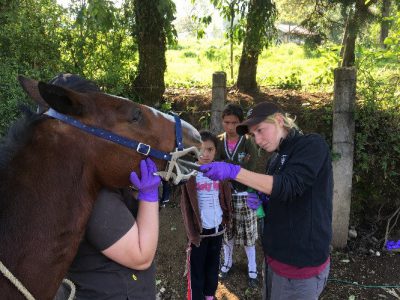
Today, we again saw a number of saddle wounds due to improperly fitted saddles and padding. Luis did a great job explaining to the people why the wounds had developed and provided helpful solutions. Luis mentioned to me that one of the reasons for the wounds is the mountainous terrain that can lead to the saddle sliding back and forth on the horse, creating wounds. Additionally, we saw a horse with numerous sarcoids that were removed, and we also saw a lot of horse shoes that were not the ideal size and position for the horses. The teams talked with the owners on ways to potentially improve the size and position of shoes in the future, which could help in this type of terrain. People in the community were very kind and offered us Coca-Cola for refreshment and asked us questions about our school and where we were lived. I spoke with a group of girls who said they were studying English and a man who had lived and worked in Kentucky for four years. We also performed about a half dozen dentistries and three castrations at the end of the day. One of the horses that presented for dentistry today was brought in by seven- and ten-year-old sisters. They were quite cute and told us that the two of them used their horse for about three hours every day of the week to collect wood from the surrounding mountains, while their two older brothers headed to Xalapa every day after school to work in construction for six-to-seven hours. Thus, everyone had to work to support the family, but they all seemed very content and reminded us of what is truly important in life.

Overall, today was a success. We learned a lot about not only the importance of animal welfare, but also about the important role the community plays in this. Understanding the people within the community, including learning, respecting, and understanding their daily lives, cultures, and traditions, is a key component of this project. I have a great amount of respect for the Donkey Sanctuary for making the community a huge part of their program and for spending a lot of time and effort within in the communities to learn from them to be able to offer a more sustainable solution for them.
At the end of the day, we all piled into the vans and headed to a local restaurant for dinner. The restaurant was a favorite of the carnivorous Donkey Sanctuary staff—carne (beef, pork, lamb, and chorizo) and queso asada with tortillas and salsas. Back in the vans and off to our next hotel in Apizaco, Tlaxcala—nearly midnight again!
Day 12
by Dr. Hal Schott
Today, we woke up to bright sunshine and cool, dry, thin air—the elevation was over 8,000 feet and Emily and I certainly noticed the difference from Veracruz on their morning jogs. We found a new breakfast buffet restaurant—we were always well fed before heading to work in the communities—with the coffee pot being a large clay jug over the stove. The restaurant was in the middle of a group of small stores, and next to it, we found large bags of “Michigan beans,” as well as homemade potato chips—quite salty, but a great late afternoon snack after sweaty work. Today, we headed a bit over an hour to an agricultural community named Alztayanca. Located 8,566 feet above sea level, the sky was a crisp blue and we had to make sure we applied our sunblock. This community was estimated to have over 6,000 working equids in the area, but we only saw about 0.1% on this day. The animals were mostly horses used for agriculture (plowing fields and transporting produce), but equids were also used to gather wood from the local mountain slopes. Not surprisingly, the air was dry at this altitude and the soil was sandy. Our work site was a sandy soccer field.
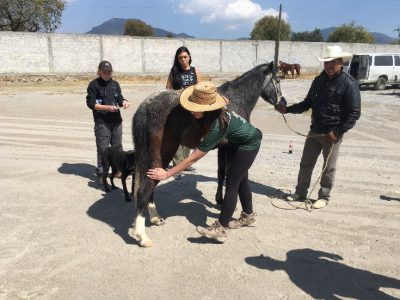
As a consequence, we saw many hard, dry feet today, and trimming 25 equids was a real challenge. We also saw a two-year-old horse with severe contraction of the deep digital flexor tendon in both front legs. The owner asked if it could be fixed and, unfortunately, the condition was too severe for any surgical intervention at this age. Amazingly, the horse was getting around fairly well with this severe conformational defect—it really had no other option. The owner also said that this problem had been observed in several of the horses in this community. They were asking about a possible nutritional problem. The horses were in good body condition otherwise, making a nutritional problem less likely, so, we considered a possible genetic problem and recommended against future breeding of the parents of this horse.
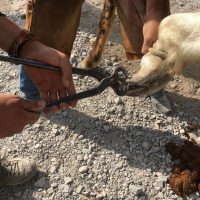
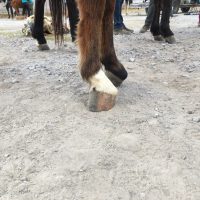
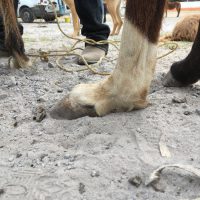
We also saw the opposite extreme of severe dropped hind fetlocks in another young horse, due to laxity of the superficial digital flexor tendon and suspensory apparatus, cause unknown.
We also performed 15 dentistries, palpated six mares for pregnancy, and performed 1 castration. I helped Bernie pull a molar from an older horse, and an owner presented a horse to Alex and complained that the horse was shaking its head. A deep ear exam revealed a few unexpected small lumps, and Alex ended up removing a number of ticks from deep with the ear canals of both ears. Hopefully, this will help!
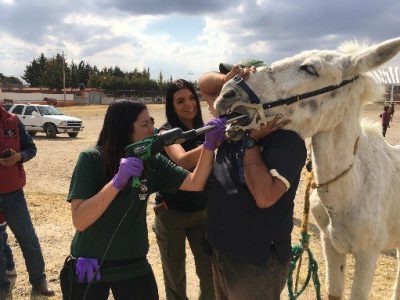
We worked with a local leader that was essentially the mayor of the community. He was quite professional and had the community members organized for our day’s work even before we arrived. This man was only 23-years-old while most of the men with the working equids were older. We talked with him for a while about the challenges for young adults in the community. They are drawn away to Xalapa and Mexico City for better paying jobs and increased social life. This trend poses a significant challenge for sustaining community and agricultural production in Alztayanca and the surrounding communities.
There was a large building at one end of the soccer field that had been used for manufacturing local produce for several decades. However, the plant closed more than a decade ago and it was now rented out as a storage facility for paper records from the larger cities! This agricultural area also was experiencing increased use of farm machinery because many of the plots of land were several acres in size. As a consequence of the challenges and changes, the future of this community and its population of working equids is uncertain.
As the day was drawing to a close, community members brought us a large tub of homemade sopes to quell the appetites we had worked up. Another product of this region is Pulque, an alcoholic beverage made from the fermented sap of the maguey plant. It is traditional to central Mexico, where it has been produced for millennia. Pulque is a milky, viscous drink with a sour yeast-like taste when unflavored. After our fill of sopes, the community leader invited us to his house for Pulque tasting. We tried the natural, unflavored version as well as strawberry- and coffee-flavored batches—another experience we would never have had unless we were welcomed into the local communities. After that, we headed back to Apicazo, and feeling somewhat deprived of food we were more used to, we headed to a pizza restaurant for dinner. Lauren said the five cheese pizza was the best she ever had!


